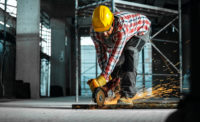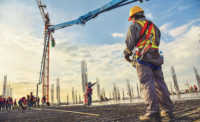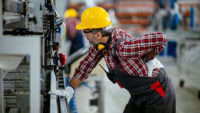Working in a manufacturing facility and environment comes with numerous safety hazards and risks. Danger comes in different shapes and forms: chemicals, large machinery, electrical sparks flying, falling objects, and sharp tools.
OSHA requires organizations to protect their workers from general workplace hazards that may cause injury or illness. Industries that require heavy lifting, where dangerous machinery is present, are also required to provide PPE to prevent outlying hazards from injuring employees.
Circumventing disasters such as injury and illness begins with trying to control a hazard to protect employees. Gaining control of safety hazards begins with initiating proactive measures, such as utilizing appropriate PPE.
Industry general standards for PPE created by OSHA are outlined to help employers select the right items to ensure safety:
- Conduct and perform a safety hazard assessment to identify areas requiring attention
- Identify the necessary PPE to control the hazard
- Train employees on the best use and practices for PPE
- Replace worn out or damaged PPE
- Create and implement a schedule for re-evaluating PPE periodically
These guidelines are an effective starting place to selecting effective PPE. However, if employers do not know what to look for in each job sector. How can they work through these guidelines without knowing the dangers intrinsic to each employee? To proactively address health and safety hazards, employers need to look at OSHA guidelines through an ergonomic lens.
There are four risk factors that manufacturing employers need to address in each and every workplace assessment: force, posture, repetition, and balance.
Force
The manufacturing industry is notorious for requiring physical activity and movement. Within the automotive manufacturing industry, it is extremely common to identify many lifting, lowering and carrying types of actions. In addition to these movements, workers are often required to lift items as heavy as 50 pounds. Employers need to keep in mind that any amount of weight added to the body can increase the amount of stress on the joints and soft tissues. In a setting such as an automotive manufacturing facility, employees are at a greater risk of force related strains if the proper footwear PPE is not in place to appropriately absorb and dissipate the extra load.
Another ergonomic example of force found in the automotive industry is the use of the body to function as a tool. For example, using the hand to screw something in, using the foot to close a cap etc. These examples are seemingly benign. However, they perfectly showcase how seemingly innocent force can appear. Utilizing a closer ergonomic lens, employers can identify that applying additional force through the body to get a job done will consequently lead to straining the joints to a point of injury.
Providing employees with dual layer 100% memory foam insoles, will give them improved shock absoprtion. Absorbing the downward forces of gravity, in addition to any external load forces, will dissipate force through the insole and reduce forces compounded at the joint and spine. Posture
Utilizing our example of the automotive manufacturing facility, it’s easy to imagine a lot of overhead work is done to access the underside of the car. This common occurrence contributes to awkward postures in two ways:
- Overhead work takes the shoulder and neck specifically into an end of range position. This creates instability in the joints, forcing them to operate from weakness, translating into potential injuries. Joints that are stressed or overextended can cause additional awkward postures, such as an arched back, which can lead to greater opportunities for aches, pains, and injuries.
- Static standing is going to contribute to the pronation (or flattening) of the arches, causing issues all the way up feet to the lower back.
These two awkward postures caused by overhead work are basically compounding at the low back – putting it at extreme risk of injury.
One way to combat fatigue induced by pronation of the feet, due to awkward postures is to utilize dual layer memory foam anti-fatigue insoles. Supporting the neutral arch of the feet greatly reduces fatigue related pronation and subsequent anterior tilt of the pelvic bone.
Repetition
Ask anyone off the street what comes to mind when you mention manufacturing, and they are bound to bring up the conveyor belt. The very act of manufacturing is known to be a repetitive series of events. For example, in pharmaceutical manufacturing, the machines may be filled by hand. Later, the filled bottles are packed into small boxes, often by hand. In both scenarios, employees are responsible for this task. In this line of work, they are standing uninterrupted for their entire shift, repeatedly calling on the muscles of their lower extremity, core, and back to maintain an upright posture. This repetition of muscle activation without break time leads to pain and discomfort because the muscles are not able to recover and therefore are not getting the appropriate nutrients. It’s like going to the gym on an empty stomach. It’s much harder than if you’ve eaten appropriately in advance.
How can employers assist employees and reduce the effects of repetition on the body? One of the greatest ways to help these workers is to ensure they have improved blood circulation to the active and static muscles, which will reduce discomfort and localized fatigue experienced in the feet, legs, knees, hips and lower back.
Everyone has experienced the pain of lower leg muscle fatigue. For example, imagine standing on your feet all day on a hard and unforgiving surface, such as concrete. Over time, you naturally begin to shift your body weight from side to side to attempt to find some natural relief for your aching legs. Instead, employers can provide PPE, such as dual layer memory foam, anti-fatigue insoles which promote blood flow and create a more supportive foundation for workers.
Balance
Finally, employers need to look out for safety hazards that could lead to a loss in balance. Food and beverage manufacturing facilities often use anti-fatigue matting sporadically throughout the facility, despite the complete inconvenience and hazard. Although seemingly convenient and safe, anti-fatigue matting can be unhygienic, create tripping and slipping hazards when wet or lack maintenance, and they lack effective coverage.
Imagine, a food and beverage manufacturing employee has just washed down their worksite at the end of the day. In a hurry to wrap up their tasks, they do not properly clean and care for the anti-fatigue mat. As they turn to clock out, they trip on the wet slippery edge of the mat which has pealed from the floor. In losing balance, they strain their muscles as they attempt to recover from the fall.
In this scenario, the employer has tried to control a safety hazard by providing anti-fatigue matting and the employee has done their part to clean the area before heading home for the day, however an injury has still occurred. Utilizing a stronger ergonomic approach to this issue, it’s easy to identify the mat is in fact, a safety hazard.
Instead, employers can offer employees dual layer memory foam insoles that provide direct contact with the foot. Direct contact with the foot allows for improved balance by increasing the support within the footwear. Dual layer 100% memory foam anit-fatigue insoles enhance footwear PPE because the wearer does not remove them until they have clocked out and away from physical danger.
Companies and businesses hoping to ensure safety through implementing OSHA guidelines also have a moral obligation to address and assess ergonomic risk factors. There is no greater obligation than to keep a workforce safe and healthy.



